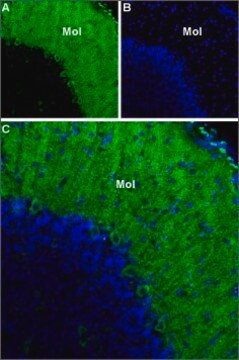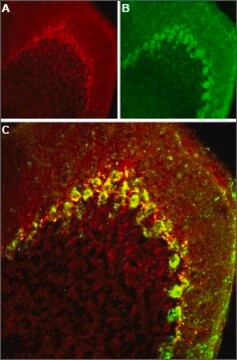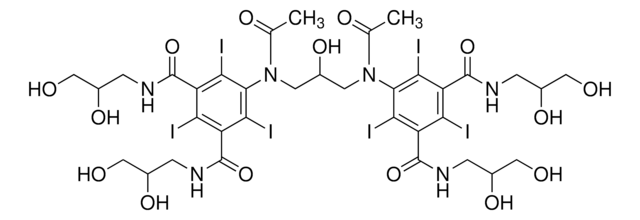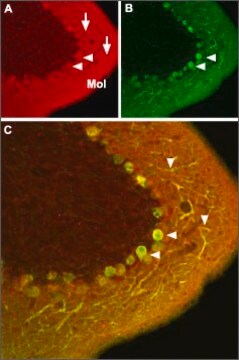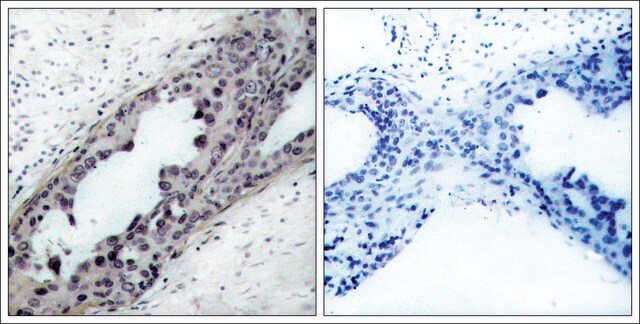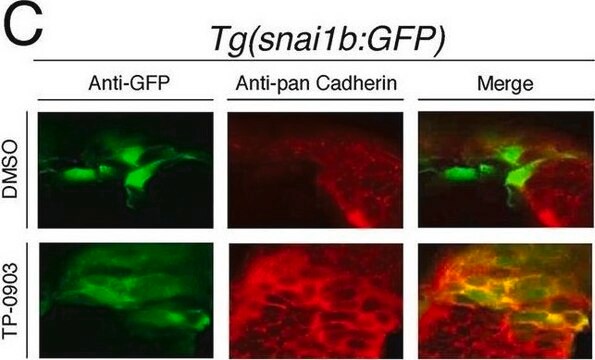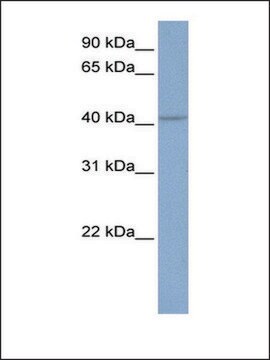C4616
Anti-Calcium Channel CaV3.3 (α1I) antibody produced in rabbit
affinity isolated antibody, lyophilized powder
Autenticatiper visualizzare i prezzi riservati alla tua organizzazione & contrattuali
About This Item
Prodotti consigliati
Origine biologica
rabbit
Livello qualitativo
Coniugato
unconjugated
Forma dell’anticorpo
affinity isolated antibody
Tipo di anticorpo
primary antibodies
Clone
polyclonal
Stato
lyophilized powder
Reattività contro le specie
rat
tecniche
western blot: 1:200 using rat brain membranes
N° accesso UniProt
Condizioni di spedizione
dry ice
Temperatura di conservazione
−20°C
modifica post-traduzionali bersaglio
unmodified
Informazioni sul gene
human ... CACNA1I(8911)
rat ... Cacna1i(56827)
Descrizione generale
Calcium channel CaV3.3 (α1I) is a low-voltage-activated T-type calcium channel. CaV3.3 (α1I) transcripts are detected in central nervous system as well as thyroid and adrenal glands.
Immunogeno
peptide corresponding to amino acid residues 1053-1067 of rat CaV3.3. Homology with other species: human is 14/15 residues identical.
Applicazioni
Anti-Calcium Channel CaV3.3 (a1I) antibody produced in rabbit is suitable for western blot at a dilution of 1:200 using rat brain membranes.
Azioni biochim/fisiol
Calcium channel CaV3.3 (α1I) is involved in neuronal excitability and is particularly recruited during the depolarizing after-potential. It is responsible for generating sustained electrical activity. Sperm specific proteins CatSper1 and CatSper2 interact with Cav3.3 and suppress Cav3.3-evoked T-type calcium channel activity.
Stato fisico
Lyophilized from phosphate buffered saline, pH 7.4, containing 1% bovine serum albumin and 0.05% sodium azide.
Esclusione di responsabilità
Unless otherwise stated in our catalog or other company documentation accompanying the product(s), our products are intended for research use only and are not to be used for any other purpose, which includes but is not limited to, unauthorized commercial uses, in vitro diagnostic uses, ex vivo or in vivo therapeutic uses or any type of consumption or application to humans or animals.
Non trovi il prodotto giusto?
Prova il nostro Motore di ricerca dei prodotti.
Prodotti correlati
Codice della classe di stoccaggio
11 - Combustible Solids
Classe di pericolosità dell'acqua (WGK)
WGK 2
Punto d’infiammabilità (°F)
Not applicable
Punto d’infiammabilità (°C)
Not applicable
Scegli una delle versioni più recenti:
Possiedi già questo prodotto?
I documenti relativi ai prodotti acquistati recentemente sono disponibili nell’Archivio dei documenti.
Edward Perez-Reyes
Physiological reviews, 83(1), 117-161 (2002-12-31)
T-type Ca2+ channels were originally called low-voltage-activated (LVA) channels because they can be activated by small depolarizations of the plasma membrane. In many neurons Ca2+ influx through LVA channels triggers low-threshold spikes, which in turn triggers a burst of action
Jin-Yong Park et al.
The Journal of biological chemistry, 279(21), 21707-21713 (2004-03-16)
Molecular cloning and expression studies established the existence of three T-type Ca(2+) channel (Ca(v)3) alpha(1) subunits: Ca(v)3.1 (alpha(1G)), Ca(v)3.2 (alpha(1H)), and Ca(v)3.3 (alpha(1I)). Although all three channels are low voltage-activated, they display considerable differences in their kinetics, with Ca(v)3.1 and
Jean Chemin et al.
The Journal of physiology, 540(Pt 1), 3-14 (2002-04-03)
In several types of neurons, firing is an intrinsic property produced by specific classes of ion channels. Low-voltage-activated T-type calcium channels (T-channels), which activate with small membrane depolarizations, can generate burst firing and pacemaker activity. Here we have investigated the
Association of Catsper1 or -2 with Ca(v)3.3 leads to suppression of T-type calcium channel activity.
Di Zhang et al.
The Journal of biological chemistry, 281(31), 22332-22341 (2006-06-03)
Sperm-specific CatSper1 and CatSper2 proteins are critical to sperm-hyperactivated motility and male fertility. Although architecturally resembling voltage-gated ion channels, neither CatSper1 nor CatSper2 alone forms functional ion channels in heterologous expression systems, which may be related to the absence of
Il team dei nostri ricercatori vanta grande esperienza in tutte le aree della ricerca quali Life Science, scienza dei materiali, sintesi chimica, cromatografia, discipline analitiche, ecc..
Contatta l'Assistenza Tecnica.